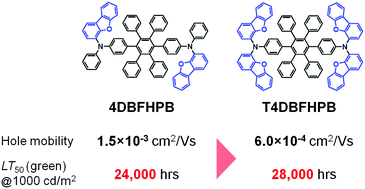A multifunctional hole-transporter for high-performance TADF OLEDs and clarification of factors governing the transport property by multiscale simulation†
Abstract
To date, a limited number of reports have been published on thermally activated delayed fluorescent (TADF) organic light-emitting devices (OLEDs) that simultaneously achieved high efficiencies and long operational lifetimes. The development of tailored-hole transporters is an effective solution because extensively used conventional hole-transport materials (HTMs), such as NPD or TAPC, are unsuitable for simultaneous realizations of high-efficiency and long-lifetime in TADF OLEDs. In this study, we developed a new four-dibenzofuran (DBF) end-capped hexaphenylbenzene (HPB)-based HTM, referred to as T4DBFHPB. Using this as the HTM, we simultaneously achieved high external quantum efficiency (ηext = 22.0%), long operational lifetime (LT50 = 28 000 h), and low-drive voltage (3.83 V) at 1000 cd m−2 in green TADF OLEDs. Our research reveals the importance of a multifunctional HTM with (i) high triplet energy (ET), (ii) high glass transition temperature (Tg), and (iii) high bond dissociation energy (BDE) of the C–N bonds in the anion state. Moreover, we conducted multiscale simulations to improve the hole-mobility (μh). Consequently, the simulation suggested that permanent-dipole-induced site energy and reorganization energy are critical factors for improving μh among HPB derivatives.

- This article is part of the themed collection: 10th Anniversary: Dedicated Authors


 Please wait while we load your content...
Please wait while we load your content...
